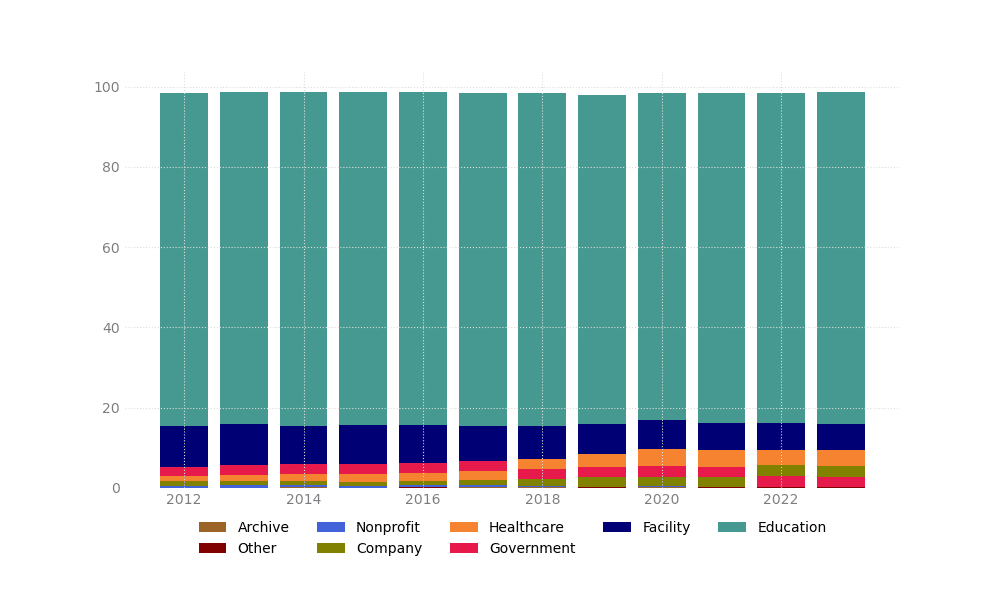Artificial intelligence (AI) has tremendous potential to transform economies and societies around the world. However, AI research and development remain highly uneven across different countries, regions and organisation types. In this analysis, we explore a few indicators that highlight the growing global divide in AI capabilities.
To define the field of AI for our analysis, we relied on the Fields of Research classification system which comes out of the box in Dimensions. Specifically, using current consultancy work we considered AI research to span the following Fields of Research:
Basic AI Fields:
- 4602 Artificial Intelligence
- 4611 Machine Learning
Applied AI Fields:
- 3102 Bioinformatics and Computational Biology
- 4903 Numerical and Computational Mathematics
- 3407 Theoretical and Computational Chemistry
- 5204 Cognitive and Computational Psychology
Distribution of AI Research Publications
Geographic distribution

This striking cartogram Figure 1 visualises the global landscape of artificial intelligence (AI) research from 2014-2023 based on academic publication outputs from countries around the world. The contours of each landmass depict the number of peer-reviewed papers contributed over the decade across core AI subfields spanning machine learning to computational mathematics.
Mirroring the data, the US dominates the cartogram with a swollen territorial outline reflecting its pole position – American institutes produced over 772,000 papers, accounting for a huge 30% share globally. China remains a major leader at approximately 465,000 papers or 18% share.
Beyond the two giants, moderately sized outlines mark the UK, Germany, Japan and others like India, Brazil and Iran – highlighting established AI research strongholds churning out 10,000 to 140,000 papers each over the period. Meanwhile Africa, South America and most Asian nations appear paltry, indicating largely untapped AI potential with less than a 5% collective contribution.
While North America, East Asia and select countries in Europe and Oceania show depth, the visual makes the divide across the Global South stark – over 80% of the world’s population reside here but with little access to resources critical to unlocking AI capabilities seen elsewhere. Addressing these deep disparities should be a top priority for transitioning towards more equitable and inclusive AI development globally.
To understand the extent of the global divide in the last 12 years, we analysed the trends in the top 10 countries that published AI research, based on Dimensions’ data for 2012-2023.

The EU27 published over 30,000 AI papers annually in the early time period, leading global output. However, China has since surpassed the EU27, rapidly rising from around 13,000 papers in 2012 to become the leading publisher with nearly 60,000 in 2023. The US which started in second position follows in third now, though its publication volume has levelled off in recent years after its initial first ranking. India has experienced major growth, with over 17,000 AI papers in 2023 compared to under 4,000 a decade prior; it even overtook the UK, which started in fourth position. Canada, Australia, Japan, Russia and South Korea maintain top 10 presence, though their year-to-year output has declined mildly in the most recent years.
The data shows emerging economies like China, India and others gaining ground in AI research, reflected by their rapidly growing publication output over the past decade. Though traditional leaders in North America and Europe continue to produce high volumes, developing countries are claiming more seats at the table and diffusing expertise globally. There is still an advantage skewed towards wealthy regions. But the statistics indicate dividing lines blurring as the playing field levels to some extent, allowing more nations to drive progress based on their own interests without barriers previously faced. Whilst gaps remain in scale and infrastructure, the global AI research landscape exhibits increased participation beyond just an exclusive Western bloc.
Balance university vs company research
We have used the Global Research Identifier Database (GRID – a database of educational and research organisations worldwide) typology to understand the distribution of AI publications between public and private research institutions from 2012-2023. GRID distinguishes organisations into categories like Archive, Company, Education, Facility, Government, Healthcare, Nonprofit, and Other.
Across all Fields of Research, the distribution of research organisation types has remained very stable from 2012-2023 across all fields, as Figure 3 shows. Education institutions (universities) produce the most research, followed by Healthcare (hospitals), Facilities (specialised research institutions), Government, Companies, Nonprofits and Archives (libraries, museums).

However, the distribution differs slightly for AI research specifically, as seen in Figure 4. While Education still leads in AI, Facilities overtake Healthcare for the second spot. Companies also publish more AI research than Governments since 2021, having surpassed Nonprofits back in 2018.

The increase in AI research authored by companies presents some concerns. Primarily, there lies an inherent conflict of interest, as companies have financial incentives to promote their own AI products and services. Their research may present biassed, overtly positive conclusions that omit negative findings, skewing the literature compared to more objective academic work.
In addition, corporate research often lacks transparency about underlying data, methods, and disclosure of limitations. Companies also frequently patent algorithms, data, and innovations based on their published research, restricting access in ways that limit follow-on research progress and collaboration.
Furthermore, the priorities guiding corporate AI research cater more closely to commercial opportunities rather than pure scientific or social value. This means that important basic research with less immediate real-world application is at risk of becoming underfunded. Lastly, the underlying profit motives may override ethical considerations around things like algorithmic bias, privacy, and security – issues that companies have less incentive to study or address.
Global North vs Global South
The following figures – 5a and 5b – show the same data in the Global North (5a) and Global South (5b). Both distributions stayed relatively stable throughout the period; the 2 largest organisation types for both were Education and Facility. However, at the start of the period, Governmental organisations were in third position in the Global South, until 2018 when it was overtaken by Healthcare organisations. Non-profit organisations publish in the Global North but very marginally in the Global South, while Companies publish more in the Global North and have an increasingly important presence in the Global South.


Funding trends
Geographic trends
Dimensions contains data about research fundings publicly available – either from the public or the private sector. We find that the dominance of China and the US in AI research output correlates strongly to funding trends.
The following figure shows global AI research funding trends from 2012 to 2020 as found in Dimensions. Analysis of the number of AI research grants funded between 2012-2020 revealed rapidly rising investment – 58.3%, while global funding across all fields of research has grown only 55.8% – across advanced and emerging economies.
The data shows the United States maintains clear dominance, increasing grants from 10,210 to 11,467 over the period examined. But Japan and China posted larger overall gains as percentages to secure second and third place in total grants by 2020. Japan more than doubled funding, granting 3,755 in 2012 swelling to 6,465 in 2020. China’s trajectory stands out, going from 4,267 to 7,345 to surpass the European Union bloc’s relatively flat numbers. Notably, the UK doubled their numbers from 2012 to 2020.
While the order shuffled, the top 10 country funders collectively ramped up research commitments substantially. Growing global recognition of AI’s revolutionary potential across practically all major industries drove heavier funding year after year from both traditional leaders and chasing contenders. If the world maintained this pace, analysts forecast total AI research funding could double again before 2030.

The data shows Brazil was consistently one of the top 10 countries providing AI research grants over the past decade, ranking 7th among those listed. As the only non-Western/European country besides China to make the top 10, Brazil’s presence highlights broader global interest and investments in AI research beyond just dominant Western regions. Though its number of AI grants is not as high as leaders like the US and EU27, the fact that Brazil has sustained over 1,200 grants annually signifies meaningful national support and participation in this research area among emerging economies. Brazil maintaining its 7th place ranking throughout the 9-year period reflects persistent research activity and funding commitments rather than being overtaken by other developing nations.
Conclusion
There are stark global divides in artificial intelligence (AI) research and development, with both publications and grants heavily concentrated in a few advanced countries over the past decade. The landscape of AI papers is dominated by the US and China, which have produced around 50% of all publications. A similar pattern emerges in AI grants, with the US and China also providing the most funding annually. A handful of other developed nations like the UK, Germany, and Japan have established strongholds in both metrics, collectively accounting for another substantial portion of global research outputs and total grants. However, the vast majority of the developing world – encompassing most countries across Africa, South America, and Asia – contributes under 5% in both metrics, significantly lagging in critical resources for progressing AI research.
While China has rapidly grown to lead AI publications, surpassing the EU, it still trails second behind the US in terms of number of AI grants funded. Emerging economies like India and Brazil are making consistent gains increasing research participation and grants provided. But their output and funding levels are still below AI research leaders. The data highlights how a handful of advanced Western countries and China continue to vastly outpace most other nations in both key AI research metrics. Though divides show some signs of blurring, deep funding and infrastructure disparities persist globally.





























